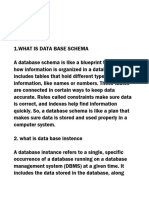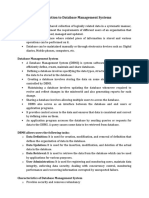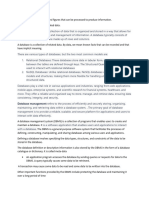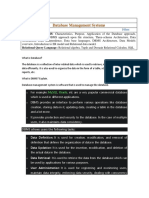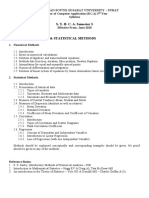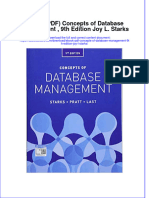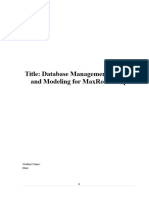03 Database Management System Revision Notes
03 Database Management System Revision Notes
Uploaded by
JdCopyright:
Available Formats
03 Database Management System Revision Notes
03 Database Management System Revision Notes
Uploaded by
JdOriginal Title
Copyright
Available Formats
Share this document
Did you find this document useful?
Is this content inappropriate?
Copyright:
Available Formats
03 Database Management System Revision Notes
03 Database Management System Revision Notes
Uploaded by
JdCopyright:
Available Formats
DATABASE MANAGEMENT SYSTEM
REVISION NOTES
A database is an organized collection of data. It is considered as a container of information. In the
manual system, you would maintain several files with different bits of information while in the
computerized system you would use database programs such as Microsoft Access, OpenOffice.org
Base, and MySQL, to organize the data as per your business need.
A database is basically a computerbased record/data/information keeping system. Data is raw,
unorganised facts and entities relevant to the user need to be processed such as a digital representation
of text, numbers, graphical images or sound. The data are stored in such a way that, they are
independent of the programs used by the people for accessing the data.
Database can be created with the help of following structures
DATABASE MANAGEMENT SYSTEM (DBMS):
DBMS is a collection of programs that enables users to create, maintain database and control all the
access to the database. It is a computer based record keeping system.
The primary goal of the DBMS is to provide an environment that is convenient and efficient for user
to retrieve and store information. It acts as an interface between the application program and the data
stored in the database.
DBMS is a software package that manages database. e.g. MySQL, INGRES, MS-Access, etc.
DBMS is actually a tool that is used to perform any kind of operation on data in database. It also
maintains data consistency in case of multiple users. The purpose of a DBMS is to bridge the gap
between information and data.
Data can be organized into two types:
Flat File: Data is stored in a single table. Usually suitable for less amount of data.
Relational: Data is stored in multiple tables and the tables are linked using a common field.
Relational is suitable for medium to large amount of data.
DATABASE SERVERS
Database servers are dedicated computers that hold the actual databases and run only the DBMS and
related software.
ADVANTAGES OF A DATABASE/DBMS
The centralised nature of database system provides several advantages, which overcome the
limitations of the conventional file processing system. These advantages are as follows
1. Reduce Data Redundancy: Redundancy means ‘duplication of data’. This eliminates the
replication of data item in different files, extra processing required to face the data item from a
large database. This also ensures data consistency and saves the storage space.
2. Enforcing Data Integrity: It means that, the data contained in the database is accurate and
consistent. Integrity constraints or consistency rules can be applied to database, so that the correct
data can be entered into the database.
3. Data Sharing: The data stored in the database can be shared among multiple users or application
programs.
Prepared by: M. S. KumarSwamy, TGT(Maths) Page - 1 -
4. Data Security: The DBMS ensures that the access of database is done only through an authorised
user.
5. Ease of Application Development: The application programmer needs to develop the application
programs according to the user’s needs.
6. Backup and Recovery: The DBMS provides backup and recovery sub-system that is responsible
to recover data from hardware and software failures.
7. Multiple Views of Data: A view may be the subset of database. Various users may have different
views of the database itself.
8. Enforced Standards: It can ensure that, all the data follow the applicable standards.
9. Data Independence: System data descriptions are independent from the application programs.
DISADVANTAGES OF A DATABASE/DBMS
There are many advantages of database, but database also have some minor disadvantages. These
disadvantages are as follows
1. Cost of Hardware and Software: Through the use of a database system, new costs are generated
due to additional hardware and software requirements.
2. Complexity: A database system creates additional complexity and requirements.
3. Database Failures: If database is corrupted due to power failure or it is corrupted on the storage
media, then our valuable data may be lost or the system will stop working.
4. Lower Efficiency: A database system is a multi-user software, which is less efficient.
SOME KEY FEATURES OF A DATABASE:
1. A database can have one or many tables. An address book example is a very simple one, in real
world there are many more details involved.
2. Each table in a database contains information about one type of item. So, a database is a container
that holds tables and other objects and manages how they can be used.
3. A record uniqueness in every table. It is important to be able to distinguish between different
items having duplicate values. Uniqueness helps to avoid accidental duplication of records caused
by user or computer error.
4. Every database table should have one or more fields designated as key. You can assign a unique
value to this key for differentiating records that may have similar names or addresses.
COMPONENTS OF A DATABASE
A database consists of several components. Each component plays an important role in the database
system environment.
The major components of database are as follows
Data: It is raw numbers, characters or facts represented by value. Most of the organisations
generate, store and process large amount of data. The data acts as a bridge between the hardware
and the software. Data may be of different types such as User data, Metadata and Application
Metadata.
Software: It is a set of programs that lies between the stored data and the users of database. It is
used to control and manage the overall computerised database. It uses different types of software
such as MySQL, Oracle, etc.
Hardware: It is the physical aspect of computer, telecommunication and database, which consists
of the secondary storage devices such as magnetic discs, optical discs, etc., on which data is
stored.
Users: It is the person, who needs information from the database to carry out its primary business
responsibilities.
TYPES OF USERS
The various types of users which can access the database system are as follows
Prepared by: M. S. KumarSwamy, TGT(Maths) Page - 2 -
Database Administrator (DBA): A person, who is responsible for managing or establishing
policies for the maintenance and handling the overall database management system is called
DBA.
Application Programmer: A person, who writes application programs in programming
languages to interact and manipulate the database are called application programmer.
End-user: A person, who interacts with the database system to perform different operations on
the database like inserting, deleting, etc., through menus or forms is called end-user.
RELATIONAL DATABASE MANAGEMENT SYSTEM (RDBMS)
RDBMS is a type of DBMS that stores data in the form of relations (tables). Relational databases are
powerful, so they require few assumptions about how data is related or how it will be extracted from
the databases.
An important feature of relational database system is that a single database can be spread across
several tables. Base, Oracle, DB2, SAP, Sybase, ASE, Informix, Access, etc., are the examples of
RDBMS.
WORKING OF A DATABASE
Database is created to operate large quantities of information by input, store, retrieve and manage the
information. It is a centralised location which provides an easy way to access the data by several
users. It does not keep the separate copies of a particular data file still a number of users can access
the same data at the same time.
As the diagram shows, DBMS works as an interface between the user and the centralised database.
First, a request or a query is forwarded to a DBMS which works (i.e. a searching process is started on
the centralised database) on the received query with the available data and if the result is obtained, it
is forwarded to the user.
If the output does not completely fulfill the requirements of the user, then a rollback (again search) is
done and again search process is performed until the desired output is obtained.
DATA INTEGRITY
Data Integrity ensures the accuracy, reliability and consistency of the data during any operation.
Each type of data integrity are as follows
Entity Integrity: It defines the primary key of a table. Entity integrity rule on a column does not
allow duplicate and null values.
Domain Integrity: It defines the type, range and format of data allowed in a column. Domain
integrity states that all values in a column must be of same type.
Referential Integrity: It defines the foreign key concepts. Referential integrity ensures that data
in related tables remains accurate and consistent before and after changes.
User Defined Integrity: If there is some business requirements which do not fit any above data
integrity then user can create own integrity, which is called user defined integrity.
Prepared by: M. S. KumarSwamy, TGT(Maths) Page - 3 -
KEY FIELDS
The key is defined as the column or the set of columns of the database table which is used to identify
each record uniquely in a relation. If a table has id, name and address as the column names, then each
one is known as the key for that table. The key field is a unique identifier for each record.
TYPES OF KEY FIELDS
The following are the types of key fields available in the DBMS system
Primary Key: A field or a set of fields that uniquely identify each record in a table is known as a
primary key. Each relation has atleast one column for which each row that must have a unique value.
Only one column attribute can be defined as a primary key for each table.
A primary key must possess the following properties
It does not allow null values.
It has a unique index.
It allows numbers and text both.
e.g. In the student’s table, StudentId works as a primary key because it contains Ids which are unique
for each student. Note: Data cannot be primary key.
Candidate Key: The set of all attributes which can uniquely identify each tuple of a relation are
known as candidate keys. Each table may have one or more candidate keys and one of them will
become the primary key. The candidate key of a relation is always a minimal key. e.g. Column
StudentId and the combination of FirstName and LastName work as the candidate keys for the
student table.
A candidate key must possess the following properties
For each row, the value of the key must uniquely identify that row.
No attribute in the key can be discarded without destroying the property of unique
identification.
Alternate Key: From the set of candidate keys after selecting one of the keys as a primary key, all
other remaining keys are known as alternate keys. e.g. From the candidate keys (StudentId,
combination of FirstName and LastName), if StudentId is chosen as a primary key, then the
combination of FirstName and LastName columns work as alternate keys.
Foreign Key: A field of a table (relation) that references the primary key of another table is referred
to as foreign key. The relationship between two tables is established with the help of foreign key. A
table may have multiple foreign keys and each foreign key can have a different referenced table.
Foreign keys play an essential role in database design, when tables are broken apart, then foreign keys
make it possible for them to be reconstructed. e.g. CourseId column of student table (reference table)
works as a foreign key as well as a primary key for course table (referenced table).
Data in a relational database management system (RDBMS) is organized in the form of tables.
DATABASE OBJECTS :
1) Table: A table is a set of data elements (values) that is organized using a model of vertical
columns and horizontal rows. A table has a defined number of columns, but can have any number
of rows. Each row is identified by the values appearing in a particular column identified as a
unique key index or the key field.
2) Columns or Fields or Attributes: A column is a set of data values of a particular simple type,
one for each row of the table. The columns provide the structure according to which the rows are
composed. For example, cFirstName, or cLastName are fields in a row.
3) Rows or Records or Tuples: A row also called a Record or Tuple represents a single data item in
a table. Each row in a table represents a set of related data, and every row in the table has the
same structure.
Prepared by: M. S. KumarSwamy, TGT(Maths) Page - 4 -
CREATING DATABASE USING OPENOFFICE:
1) Open the OpenOffice Base Application by Clicking on Start>Programs>OpenOffice.org
4>OpenOffice.org Base.
2) Create a new database by selecting the option Create a new database
3) Database wizard appear. Click Finish. The Save As dialog box appears.
4) Specify a name for the database in the File name: field and click Save.
CREATE TABLES:
Tables are the basic building blocks of a database. You store the data in the database in the form of
tables.
There are different ways to create a table:
a) Use Wizard To Create Table:
The following are the steps to create a table:
1) Click on Tables > Use Wizard to Create Table
2) Click the Select Fields > Choose Category > Select the table > Click on Next Button.
3) Select the fields as per the requirements. Click on Next button
4) Set the data types and properties of the selected fields. Click on Next Button
5) Set the Primary Key and Click on Next Button
6) Window to rename the table will open. A user can either go ahead with the same table name or
can change it.
7) Click on Finish to insert the data in the table.
b) Creating table using Design View
1) Click on Create Table in Design View.
2) Specify the field name and data type of the field.
3) Save the table by clicking on File > Save
4) Specify the table name. The default name is Table1. Click OK.
5) An alert appears, if there is no primary key in the table.
6) Click yes and set the primary key and finally save the table.
DATA TYPES:
Datatypes are used to identify which type of data (value) we are going to store in the database. Data
types in OpenOffice base are broadly classified into five categories listed below.
Numeric Types
Alphanumeric Types
Binary Types
Date time
Other Variable types
Numeric Types: Numeric data types in a database can be used for storing information such as mobile
number, roll number, door number etc. The different types of numeric data types available are listed
here.
Prepared by: M. S. KumarSwamy, TGT(Maths) Page - 5 -
Alphanumeric Types: This data type is used to store information which has alphabets as well as
numbers for example address, book summary field etc. The different types of Alphanumeric Types
available are listed here.
Binary Types: Binary data types are used for storing data in binary formats. Binary data types in a
database can be using for storing photos, music files, etc.
Date time: Date time data types in a database can be used for storing information such as date of
birth, date of admission, date of product sale, etc.
Prepared by: M. S. KumarSwamy, TGT(Maths) Page - 6 -
OTHER DATA TYPES:
PERFORM OPERATIONS ON TABLE
In OpenOffice Base, data is stored in tables which can be inserted, modified and removed using
appropriate options.
Inserting Data In The Table:
To insert the data in the table, follow the steps:
1) Select the table > Double click on it.
2) The table will open in Datasheet View.
3) Insert the required number of records in Datasheet View.
Editing Records In The Table:
To edit the data in the table, follow the steps:
1) Select the table > Double click on it.
2) The table will open in Datasheet View.
3) Edit the required record in Datasheet View.
Deleting Records From The Table:
To remove the data from the table, follow the steps:
1) Select the table > Double click on it.
2) The table will open in Datasheet View.
3) Select the data > right click on selected data > select the Delete option
FIELD PROPERTIES:
To set the field properties: Select the table > Right click > Select the option Edit > the table will open
in Design View.
In design view there are different properties of fields according to the data type set for each field.
The properties of numeric type data is given below :
1) AutoValue – if set to yes then field will get the auto numeric values.
2) AutoValue – if set to yes then field will get the auto numeric values.
3) Length – By default length of the field is 10 but the size of the field can be set to maximum
length.
4) Default Value – A default value can be set for a field if user don’t provide any value while
entering the values in the table.
5) Format – This property helps to set the format of the data entered in the field such as 91-222-333.
The properties of character type data is shown below :
1) Entry Required – if set to yes then it will be must to insert the value in the field.
Prepared by: M. S. KumarSwamy, TGT(Maths) Page - 7 -
2) Length – By default length of the field is 10 but the size of the field can be set to maximum length.
3) Default Value – A default value can be set for a field if user don’t provide any value while
entering the values in the table.
4) Format – This property helps to set the format of the data entered in the field such as 91-222-333.
SORTING DATA: Sorting means to arrange the data in either ascending order of descending order.
REFERENTIAL INTEGRITY:
Referential integrity is used to maintain accuracy and consistency of data in a relationship. In Base,
data can be linked between two or more tables with the help of primary key and foreign key
Referential integrity helps to avoid:
1) Adding records to a related table if there is no associated record available in the primary key table.
2) Changing values in a primary if any dependent records are present in associated table(s).
3) Deleting records from a primary key table if there are any matching related records available in
associated table(s).
CREATING AND EDITING RELATIONSHIPS BETWEEN TABLES:
A relationship refers to an association or connection between two or more tables. Relationships
between tables helps to:
Save time as there is no need to enter the same data in separate tables.
Reduce data-entry errors.
Summarize data from related tables.
You can create a relationship between any two tables by selecting Relationships option from the
Tools menu.
There are three types of relationships which can be created in tables:
1) ONE to ONE Relationship: In this relationship, both the tables must have primary key columns.
2) One to Many Relationship: In this relationship, one of the table must have primary key column.
3) Many to Many Relationship: In this relationship, no table has the primary key column.
REMOVE THE RELATIONSHIPS:
The relationships applied on the tables can be removed also with the help of Delete option. Right
Click on the relationship thread and select Delete option.
RETRIEVE DATA USING QUERY
A query is to collect specific information from the pool of data. A query helps us join information
from different tables and filter that information
OR
Queries are commands that are used to define the data structure and also to manipulate the data in the
database.
There are two types of languages:-
DDL (Data Definition Language)
DML (Data Manipulation Language)
DATA DEFINITION LANGUAGE (DDL)
DDL is used to define the structure of your tables and other objects in the database. In DBMS, it is
used to specify a database schema as a set of definitions (expressed in DDL). In SQL, the Data
Definition Language allows you to create, alter and destroy database objects. Basically, a data
definition language is a computer language used to create and modify the structure of database
objects in a database. These database objects include views, schemes, tables, indexes, etc.
This term is also known as data description language in some contexts, as it describes the fields and
records in a database table.
Prepared by: M. S. KumarSwamy, TGT(Maths) Page - 8 -
Data definition language consists of various commands that lets you to perform some specified tasks
as follows
1) CREATE: Uses to create objects in the database.
2) ALTER: Uses to alter the structure of the database table. This command can add up additional
columns, drop existing columns and even change the data type of columns involved in a database
table.
3) DROP: Uses to delete objects from the database.
4) TRUNCATE: Uses to remove all records from a table.
5) RENAME: Uses to rename an object.
DATA MANIPULATION LANGUAGE (DML)
DML provides various commands used to access and manipulate data in existing database. This
manipulation involves inserting data into database tables, retrieving existing data, deleting data from
existing tables and modifying existing data.
DML is mostly incorporated in SQL database. The basic goal of DML is to provide efficient human
interaction with the system.
The DMLs are of two types
Procedural DMLs These require a user to specify what data is needed and how to get it.
Non-Procedural DMLs These require a user to specify what data is needed without specifying how to
get it.
Various data manipulation language commands are as follows
1) SELECT: Used to retrieve data from a database.
2) INSERT: Used to insert data into a table.
3) UPDATE: Used to update existing data within a table.
4) DELETE: Used to delete all records from a table, the space of the records remains.
5) LOCK TABLE: Used to control concurrency.
SELECT STATEMENT :
A SELECT statement retrieves zero or more rows from one or more tables. SELECT is the most
commonly used Data Manipulation Language(DML) command. To retrieve all the columns in a table
the syntax is: SELECT * FROM <Table Name>;
For example, if you want to display all the data from table emp (short form of employee), the
command is
Select * from emp;
The SELECT statement has many optional clauses:
WHERE specifies which rows to retrieve.
ORDER BY specifies an order in which to return the rows.
for example : Select * from emp where name = “Ravi”;
The above query will show result of a particular employee named “Ravi”.
Select * from emp order by Salary;
The above query will show all the records of table emp according to ascending order of column
Salary.
PERFORMING CALCULATIONS :
In Base, simple calculations can be done on the data using arithmetic operators. Example:
1) To display the salary of all the employees after incrementing by 1000 then the following SQL
command will be executed in Base. (Fields of table Employee are EmployeeID, FirstName, Salary)
Select “EmployeeID”, “FirstName”, “Salary” +1000 from “Employee”;
Prepared by: M. S. KumarSwamy, TGT(Maths) Page - 9 -
2) To display the salary of all the employees after decreasing by 10000 then the SQL command will
be:
Select “EmployeeID”, “FirstName”, “Salary” – 10000 from “Employee”;
3) To display the salary of all the employees after incrementing it as twice the amount of present
salary, then the SQL command will be .
Select “EmployeeID”, “FirstName”, “Salary” * 2 from “Employee”
UPDATE STATEMENT :
Update statement is used for modifying records in a database. The general syntax of the update
statement is as follows:
UPDATE <table name> SET <Column name > = value [WHERE <Condition>];
for example :
1) To increase(update) the salary of employee “Ravi” by Rs 2000 (in table Employee)then the SQL
command will be:
Update Employee set Salary = Salary + 2000 Where FirstName = “Ravi”;
CREATE FORMS AND REPORTS USING WIZARD
FORM: A form provides the user a systematic way of storing information into the database. It is an
interface in a user specified layout that lets users to view, enter, and change data directly in database
objects such as tables.
Creating Form Using Wizard : Steps To Create Form Using Wizard are :
1) Click Use Wizard to Create Form… option under Tasks group. The Form Wizard dialog box
appears.
2) Select selective fields to be sent onto the form by selecting the field name and clicking >button
and click Next.
3) Select the option Add Subform if you need to insert the contents in the table in a separate form
and click Next.
4) Arrange selected fields in a form and click Next.
5) Select the data entry mode and click Next.
6) Specify the styles to be used in the form and click Next.
7) Specify the name of the form. Click Finish.
REPORT: A report helps to display the data in a summarized manner. It is used to generate the
overall work outcome in a clear format.
Creating Reports using wizard : Steps To Create Report Using Wizard are :
1) Click on Use Wizard to Create Report… option available under Tasks.
2) Select all the table fields by selecting the >> button.
3) Redefine the label of the fields in the reports or else you can set the default name and click Next.
4) Define grouping for the fields of the table if required and click Next
5) Sort the field in the report by selecting the appropriate field name and sorting method(if required)
and click Next.
6) Select the layout of the report and click Next.
7) Define a name for the report and click Finish.
Prepared by: M. S. KumarSwamy, TGT(Maths) Page - 10 -
You might also like
- 03 Database Management SystemDocument45 pages03 Database Management Systemsayan.sikdar021No ratings yet
- 03 Database Management System Revision NotesDocument10 pages03 Database Management System Revision Notessahuarsh320No ratings yet
- 03 Database Management System Revision NotesDocument12 pages03 Database Management System Revision Notestiasneha06No ratings yet
- 03 Database Management System Revision NotesDocument10 pages03 Database Management System Revision Noteslakshay ManglaNo ratings yet
- Database Management System XDocument10 pagesDatabase Management System XVivek KumarNo ratings yet
- Relational Database and SQLDocument35 pagesRelational Database and SQLbarwaliyaheer25No ratings yet
- RDBMS Important Questions With AnswersDocument102 pagesRDBMS Important Questions With AnswersVsarchana QaNo ratings yet
- DBMS NotesDocument25 pagesDBMS NotesChaya AnuNo ratings yet
- DBMS Assigment 1Document17 pagesDBMS Assigment 1khairnardipak776No ratings yet
- 61bdbf4846c3f - Database Management System 2078Document9 pages61bdbf4846c3f - Database Management System 2078Anuska ThapaNo ratings yet
- Unit - 3 Realtional Database Management SystemDocument35 pagesUnit - 3 Realtional Database Management SystemMiriam JomonNo ratings yet
- Chitransh File BDPSDocument26 pagesChitransh File BDPSChitransh RanaNo ratings yet
- Unit-I DBMSDocument32 pagesUnit-I DBMSvenkata prasad venkata prasadNo ratings yet
- Dbms NotesDocument37 pagesDbms Notesanimeshsingh2207No ratings yet
- Basics of DBDocument5 pagesBasics of DBjenifer JesusNo ratings yet
- Advantages of DbmsDocument2 pagesAdvantages of Dbmsrajat19915018No ratings yet
- Advantages of DbmsDocument2 pagesAdvantages of Dbmsrajat19915018No ratings yet
- Unit 1: Data Base Management SystemDocument22 pagesUnit 1: Data Base Management SystemRajat SharmaNo ratings yet
- Database ss3 WK 4&5Document6 pagesDatabase ss3 WK 4&5solomonchuks19No ratings yet
- Database Healthinfo 180513155229Document50 pagesDatabase Healthinfo 180513155229Danlami ChieNo ratings yet
- Database Management Systems (3:0:0) : Sub Code: 21IS4C04Document111 pagesDatabase Management Systems (3:0:0) : Sub Code: 21IS4C04EAKEHEH HNo ratings yet
- DDDocument5 pagesDDsaichanderNo ratings yet
- DBMS Complete NotesDocument47 pagesDBMS Complete NotesMeenakshi SaiNo ratings yet
- RDBMS Unit - IDocument38 pagesRDBMS Unit - Iserboyka18No ratings yet
- Introduction To Database Management SystemsDocument27 pagesIntroduction To Database Management SystemsAlok KhuntiaNo ratings yet
- Database in MYSQLDocument16 pagesDatabase in MYSQLadarsh sarafNo ratings yet
- Dbms Module 1Document40 pagesDbms Module 1kripakbenzeerNo ratings yet
- Bca III Semester Dbms Notes Unit Wise Unit 1 - Jims (Pdfdrive)Document97 pagesBca III Semester Dbms Notes Unit Wise Unit 1 - Jims (Pdfdrive)Rehman PashaNo ratings yet
- Unit - I Database Mangement SystemsDocument12 pagesUnit - I Database Mangement SystemsMsr. B. Jeyalakshmi Assistant ProfessorNo ratings yet
- Introduction To Database Management SystemDocument3 pagesIntroduction To Database Management Systemcsoumyadeep950No ratings yet
- Database Management SystemDocument11 pagesDatabase Management SystemDinesh KumarNo ratings yet
- Practical FileDocument9 pagesPractical FileHarjit Singh SainiNo ratings yet
- What Is A Database?Document4 pagesWhat Is A Database?paul degzNo ratings yet
- ISO 90012015 Certified InstituteDocument8 pagesISO 90012015 Certified InstituteNiriellage DilrukshiNo ratings yet
- Assignmt1 (522) Wajid SirDocument11 pagesAssignmt1 (522) Wajid SirDil NawazNo ratings yet
- BANA 2 ReviewerDocument6 pagesBANA 2 ReviewerDELOS REYES, PATRICK JEROME B.No ratings yet
- DBMS Unit 1Document71 pagesDBMS Unit 1Nishita PandeyNo ratings yet
- Unit:-I (Database Concepts) Topic: - Introduction To Database Lecture: - 1-2 Dated: - 01.01.2020 - 02.01.2021Document5 pagesUnit:-I (Database Concepts) Topic: - Introduction To Database Lecture: - 1-2 Dated: - 01.01.2020 - 02.01.2021gourav sainiNo ratings yet
- IMS Concepts and Database AdministrationDocument99 pagesIMS Concepts and Database AdministrationitdsenNo ratings yet
- MIS Tim UNIT 3Document45 pagesMIS Tim UNIT 3Vishnu R NairNo ratings yet
- C.S. ProjectDocument19 pagesC.S. ProjectArchit SharmaNo ratings yet
- Fundamental of Database SystemsDocument28 pagesFundamental of Database Systemsayushisingla712005No ratings yet
- Chapter A2Document21 pagesChapter A2vibhormurtiNo ratings yet
- Computer Science Option A DatabaseDocument9 pagesComputer Science Option A DatabaseKrish Madhav ShethNo ratings yet
- MateDocument89 pagesMateSivaSankarKatariNo ratings yet
- DBMS-Introduction To Database Management Systems NotesDocument36 pagesDBMS-Introduction To Database Management Systems NotesKomal Ramteke100% (2)
- Class 10 DBMSDocument41 pagesClass 10 DBMSkumarishu1423No ratings yet
- DatabaseDocument19 pagesDatabaseSamim IslamNo ratings yet
- IM III Unit NotesDocument41 pagesIM III Unit Notesshaik.712239No ratings yet
- Cosc 305Document15 pagesCosc 305abubakarumarfarouq667No ratings yet
- Database Unit1 Notes For ReferenceDocument19 pagesDatabase Unit1 Notes For ReferenceSaban ChoudhuryNo ratings yet
- Data DaseDocument2 pagesData DaseFrinces PerancoNo ratings yet
- Unit-1 - Notes DbmsDocument47 pagesUnit-1 - Notes Dbmsjareenaperveen786No ratings yet
- DBMS DefinitionDocument14 pagesDBMS DefinitionAslam KhanNo ratings yet
- ISO 90012015 Certified InstituteDocument10 pagesISO 90012015 Certified InstituteNiriellage DilrukshiNo ratings yet
- DBMS NOTES (Module4)Document26 pagesDBMS NOTES (Module4)Surivkl VklNo ratings yet
- 1.1 Introduction To Databases: DatabaseDocument11 pages1.1 Introduction To Databases: DatabaseHarshithaNo ratings yet
- DBMS_Unit1Document44 pagesDBMS_Unit1anju143gunaNo ratings yet
- THE SQL LANGUAGE: Master Database Management and Unlock the Power of Data (2024 Beginner's Guide)From EverandTHE SQL LANGUAGE: Master Database Management and Unlock the Power of Data (2024 Beginner's Guide)No ratings yet
- S. Y. B. C. A. Semester 3 301 Numerical & Statistical MethodsDocument8 pagesS. Y. B. C. A. Semester 3 301 Numerical & Statistical Methodsviharatoo7827100% (1)
- Chapter 11: Indexing and Storage: Modified From: Database System Concepts, 6 EdDocument53 pagesChapter 11: Indexing and Storage: Modified From: Database System Concepts, 6 EdDevika HarikrishnanNo ratings yet
- SFDC Velocity Corporate Training CenterDocument7 pagesSFDC Velocity Corporate Training Centerakshay yerawarNo ratings yet
- Big Data Information Governance by Accountants: Emily M. Coyne Joshua G. Coyne Kenton B. WalkerDocument19 pagesBig Data Information Governance by Accountants: Emily M. Coyne Joshua G. Coyne Kenton B. Walkerمعن الفاعوريNo ratings yet
- Database Systems Lecture 2Document40 pagesDatabase Systems Lecture 2rajiwuloNo ratings yet
- MIS - Lect 7Document16 pagesMIS - Lect 7asher baigNo ratings yet
- Sample Test - Exam 000-470 - IBM Unica Campaign V8.5Document3 pagesSample Test - Exam 000-470 - IBM Unica Campaign V8.5Matthew ReachNo ratings yet
- Chapter 10-DataBase Transaction FinalDocument7 pagesChapter 10-DataBase Transaction FinalGhanshyam SharmaNo ratings yet
- Registros Online Na PoloniaDocument2 pagesRegistros Online Na Polonialucas.bergonsiNo ratings yet
- Part A: Question 1 What Is Data Warehouse Schema? Explain Different Types of SchemaDocument6 pagesPart A: Question 1 What Is Data Warehouse Schema? Explain Different Types of Schemayogesh raoNo ratings yet
- DDF Builder Users GuideDocument148 pagesDDF Builder Users GuideAdNo ratings yet
- Computer Science and Engineering 2nd Year - Pub - Date - 15092019Document10 pagesComputer Science and Engineering 2nd Year - Pub - Date - 15092019SabbirNo ratings yet
- Bi and Data Sharing ShermanDocument12 pagesBi and Data Sharing Shermanfero_sher22No ratings yet
- Mod Datalake Dremio Spark Iceberg 012524pdfDocument64 pagesMod Datalake Dremio Spark Iceberg 012524pdfAdolfoGarciaNo ratings yet
- A Survey On RDBMS and NoSQL Databases MySQL Vs MongoDBDocument7 pagesA Survey On RDBMS and NoSQL Databases MySQL Vs MongoDBGb PakuyNo ratings yet
- Big Data Hadoop & Spark: Certification TrainingDocument22 pagesBig Data Hadoop & Spark: Certification TrainingTimothy SausaNo ratings yet
- Ebook PDF Concepts of Database Management 9th Edition Joy L Starks PDFDocument41 pagesEbook PDF Concepts of Database Management 9th Edition Joy L Starks PDFamy.martin707100% (51)
- Int QuestionsDocument11 pagesInt Questionssankush phatarpekarNo ratings yet
- Added Please Check NowgdgdDocument34 pagesAdded Please Check NowgdgdfiremmtNo ratings yet
- Class 12 Ip Practical Exercises 2022-23 (Updated)Document29 pagesClass 12 Ip Practical Exercises 2022-23 (Updated)priyanmishra921No ratings yet
- Optimistic Locking With Concurrency - PLSQLDocument9 pagesOptimistic Locking With Concurrency - PLSQLsuman_vemula22No ratings yet
- List of ABAP KeywordsDocument14 pagesList of ABAP KeywordsSam OneNo ratings yet
- SQL DBMS AssignmentDocument3 pagesSQL DBMS AssignmentHamza SajidNo ratings yet
- Backing Up SQL Server DatabasesDocument27 pagesBacking Up SQL Server DatabasesPhilNo ratings yet
- Final DBDocument26 pagesFinal DBmanan1.sushmaNo ratings yet
- How To Influence The DB2 Query Optimizer Using Optimization ProfilesDocument52 pagesHow To Influence The DB2 Query Optimizer Using Optimization ProfilesJames L. ChamberlainNo ratings yet
- Chapter 5 Normalization of Database TablesDocument58 pagesChapter 5 Normalization of Database TablesimannurumairahNo ratings yet
- Quizzes For SQLDocument83 pagesQuizzes For SQLjulie stichtNo ratings yet
- Object Database Management SystemDocument27 pagesObject Database Management Systemsimply_cooolNo ratings yet
- C LectureDocument8 pagesC LectureNaseem AhamadNo ratings yet


























